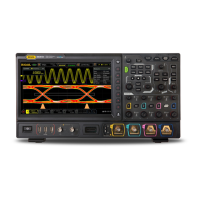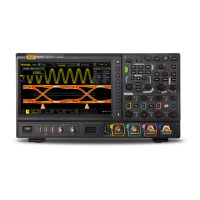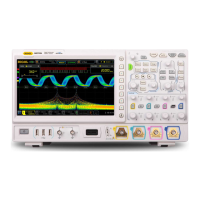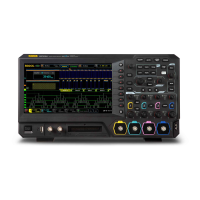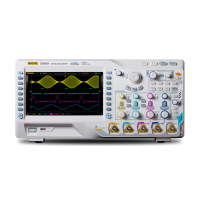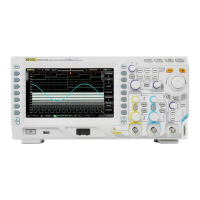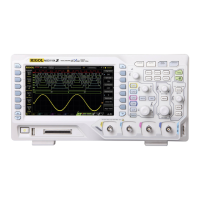
Do you have a question about the Rigol MSO8204 and is the answer not in the manual?
| Bandwidth | 2 GHz |
|---|---|
| Channels | 4 |
| Operating Temperature | 0°C to +50°C |
| Memory Depth (analog) | 500 Mpts |
| Vertical Resolution | 8 bit |
| Input Impedance | 1 MΩ |
| Maximum Input Voltage | 400 V (DC + AC peak) |
| Trigger Types | Edge, Pulse, Runt, Window |
| Interface | USB, LAN, HDMI |
| Sample Rate (analog) | 10 GSa/s (2 Channels), 5 GSa/s (4 Channels) |
Outlines general safety precautions before operating the instrument to prevent injury or damage.
Explains safety notices and symbols used in the manual and on the product for hazard identification.
Explains how to configure the vertical system settings for analog channels, including scale, offset, and coupling.
Details how to adjust the horizontal system settings, including time base, position, and delayed sweep.
Covers settings related to the sample system, such as timebase modes, acquisition modes, and memory depth.
Explains how to select the trigger source, including analog channels, digital channels, external trigger, and AC line.
Describes how to adjust the trigger level or threshold level based on the selected trigger source type.
Details the available trigger modes: Auto, Normal, and Single, and their operational characteristics.
Lists and describes the various trigger types supported by the oscilloscope, including edge, pulse, and pattern triggers.
Explains how to perform various mathematical operations on waveforms, including arithmetic, FFT, logic, and function operations.
Describes how to use the auto measurement function to quickly measure waveform parameters and display statistics.
Details how to use cursors (X and Y) to measure time, frequency, amplitude, and phase parameters of waveforms.
Explains the operation of the built-in 3-digit digital voltmeter for voltage measurements on analog channels.
Describes the built-in frequency counter for measuring frequency, period, and edge events on analog channels.
Describes how to enable or disable the histogram analysis function for statistical views of waveforms.
Explains the real-time eye diagram function for analyzing signal integrity and inter-symbol interference.
Details the jitter analysis function for measuring signal integrity and variance over time, identifying error sources.
Guides on how to select digital channels (D0-D15) or user-defined groups for logic analysis.
Explains how to enable or disable individual digital channels or groups for logic analysis.
Describes how to set the logic threshold level for distinguishing between logic "1" and "0" for digital signals.
Describes the parallel decoding function, including clock settings, bus settings, and display options.
Details the RS232 protocol decoding, including baud rate, source settings, and data package configurations.
Explains the I2C protocol decoding, covering source settings, address information, and display options.
Describes the SPI protocol decoding, including mode settings, source configuration, and data settings.
Details the LIN protocol decoding, covering source, signal, and display-related settings.
Explains the CAN protocol decoding, including source, signal type, baud rate, and sample position settings.
Describes the FlexRay protocol decoding, covering source, signal rate, sample position, and display settings.
Details the I2S protocol decoding, including source settings, bus settings, and display-related configurations.
Guides on enabling or disabling the pass/fail test function for product testing and validation.
Provides step-by-step instructions for establishing remote control via the USB interface, including driver installation.
Explains how to configure network parameters and establish remote control via the LAN interface.
Covers connecting and setting up the GPIB interface for remote control, including driver installation and address configuration.
Offers solutions for when no signal waveform is displayed, including probe connection and signal resampling.
